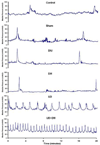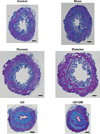Roles of polyuria and hyperglycemia in bladder dysfunction in diabetes
- PMID: 22999997
- PMCID: PMC4104602
- DOI: 10.1016/j.juro.2012.08.222
Roles of polyuria and hyperglycemia in bladder dysfunction in diabetes
Erratum in
- J Urol. 2013 Aug;190(2):816
Abstract
Purpose: Diabetes mellitus causes diabetic bladder dysfunction. We identified the pathogenic roles of polyuria and hyperglycemia in diabetic bladder dysfunction in rats.
Materials and methods: A total of 72 female Sprague-Dawley® rats were divided into 6 groups, including age matched controls, and rats with sham urinary diversion, urinary diversion, streptozotocin induced diabetes mellitus after sham urinary diversion, streptozotocin induced diabetes mellitus after urinary diversion and 5% sucrose induced diuresis after sham urinary diversion. Urinary diversion was performed by ureterovaginostomy 10 days before diabetes mellitus induction. Animals were evaluated 20 weeks after diabetes mellitus or diuresis induction. We measured 24-hour drinking and voiding volumes, and cystometry. Bladders were harvested to quantify smooth muscle, urothelium and collagen. We measured nitrotyrosine and Mn superoxide dismutase in the bladder.
Results: Diabetes and diuresis caused increases in drinking and voiding volume, and bladder weight. Bladder weight decreased in the urinary diversion group and the urinary diversion plus diabetes group. The intercontractile interval, voided volume and compliance increased in the diuresis and diabetes groups, decreased in the urinary diversion group and further decreased in the urinary diversion plus diabetes group. Total cross-sectional tissue, smooth muscle and urothelium areas increased in the diuresis and diabetes groups, and decreased in the urinary diversion and urinary diversion plus diabetes groups. As a percent of total tissue area, collagen decreased in the diuresis and diabetes groups, and increased in the urinary diversion and urinary diversion plus diabetes groups. Smooth muscle and urothelium decreased in the urinary diversion and urinary diversion plus diabetes groups. Nitrotyrosine and Mn superoxide dismutase increased in rats with diabetes and urinary diversion plus diabetes.
Conclusions: Polyuria induced bladder hypertrophy, while hyperglycemia induced substantial oxidative stress in the bladder, which may have a pathogenic role in late stage diabetic bladder dysfunction.
Copyright © 2013 American Urological Association Education and Research, Inc. Published by Elsevier Inc. All rights reserved.
Figures



Similar articles
-
Short-term diabetes- and diuresis-induced alterations of the bladder are mostly reversible in rats.Int J Urol. 2015 Apr;22(4):410-5. doi: 10.1111/iju.12695. Epub 2015 Jan 14. Int J Urol. 2015. PMID: 25588853
-
Comparison of urinary bladder function in rats with hereditary diabetes insipidus, streptozotocin-induced diabetes mellitus, and nondiabetic osmotic diuresis.J Urol. 1994 Feb;151(2):496-502. doi: 10.1016/s0022-5347(17)35001-2. J Urol. 1994. PMID: 8283565
-
Temporal morphological and functional impact of complete urinary diversion on the bladder: a model of bladder disuse in rats.J Urol. 2010 Nov;184(5):2179-85. doi: 10.1016/j.juro.2010.06.090. Epub 2010 Sep 17. J Urol. 2010. PMID: 20850838 Free PMC article.
-
Diabetic bladder dysfunction.Chin Med J (Engl). 2014;127(7):1357-64. Chin Med J (Engl). 2014. PMID: 24709194 Free PMC article. Review.
-
Diabetic bladder dysfunction: current translational knowledge.J Urol. 2009 Dec;182(6 Suppl):S18-26. doi: 10.1016/j.juro.2009.08.070. J Urol. 2009. PMID: 19846137 Free PMC article. Review.
Cited by
-
Effects of different diets used to induce obesity/metabolic syndrome on bladder function in rats.Am J Physiol Regul Integr Comp Physiol. 2023 Jan 1;324(1):R70-R81. doi: 10.1152/ajpregu.00218.2022. Epub 2022 Nov 14. Am J Physiol Regul Integr Comp Physiol. 2023. PMID: 36374176 Free PMC article.
-
NLRP3 Promotes Diabetic Bladder Dysfunction and Changes in Symptom-Specific Bladder Innervation.Diabetes. 2019 Feb;68(2):430-440. doi: 10.2337/db18-0845. Epub 2018 Nov 13. Diabetes. 2019. PMID: 30425063 Free PMC article.
-
The endangered common hamster needs proteins: identifying diversified crop-based diets improving hibernation and reproductive success.Conserv Physiol. 2024 Dec 13;12(1):coae082. doi: 10.1093/conphys/coae082. eCollection 2024. Conserv Physiol. 2024. PMID: 39678701 Free PMC article.
-
Toll-Like Receptor 4 Activation Contributes to Diabetic Bladder Dysfunction in a Murine Model of Type 1 Diabetes.Diabetes. 2016 Dec;65(12):3754-3764. doi: 10.2337/db16-0480. Epub 2016 Sep 20. Diabetes. 2016. PMID: 27650857 Free PMC article.
-
Oxidative Stress: A Putative Link Between Lower Urinary Tract Symptoms and Aging and Major Chronic Diseases.Front Med (Lausanne). 2022 Mar 10;9:812967. doi: 10.3389/fmed.2022.812967. eCollection 2022. Front Med (Lausanne). 2022. PMID: 35360727 Free PMC article. Review.
References
-
- Frimodt-Moller C. Diabetic cystopathy: epidemiology and related disorders. Ann Intern Med. 1980;92:318. - PubMed
-
- Kaplan SA, Te AE, Blaivas JG. Urodynamic findings in patients with diabetic cystopathy. J Urol. 1995;153:342. - PubMed
-
- Overcoming Bladder Disease: A Strategic Plan for Research. A report of the bladder research progress review group, National Institute of Diabetes and Digestive and Kidney Diseases. Chapter 10. National Institues of Health; 2002. Bladder Research Progress Review Group: Urologic complications of diabetes mellitus.
-
- Liu G, Daneshgari F. Temporal diabetes- and diuresis-induced remodeling of the urinary bladder in the rat. Am J Physiol Regul Integr Comp Physiol. 2006;291:R837. - PubMed
Publication types
MeSH terms
Grants and funding
LinkOut - more resources
Full Text Sources
Other Literature Sources
Medical
Research Materials

